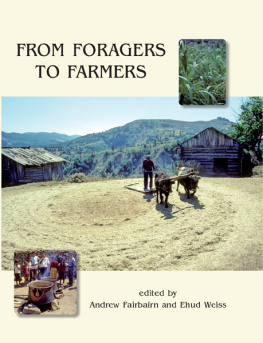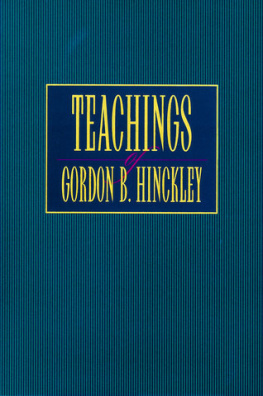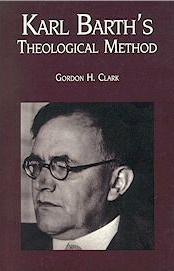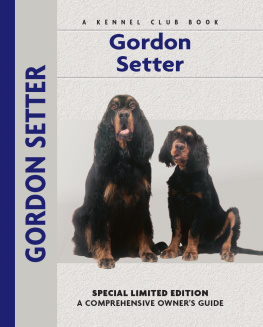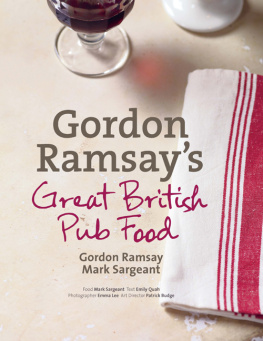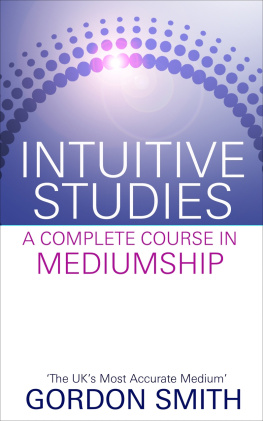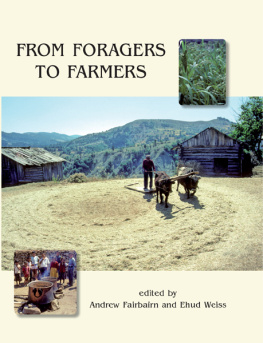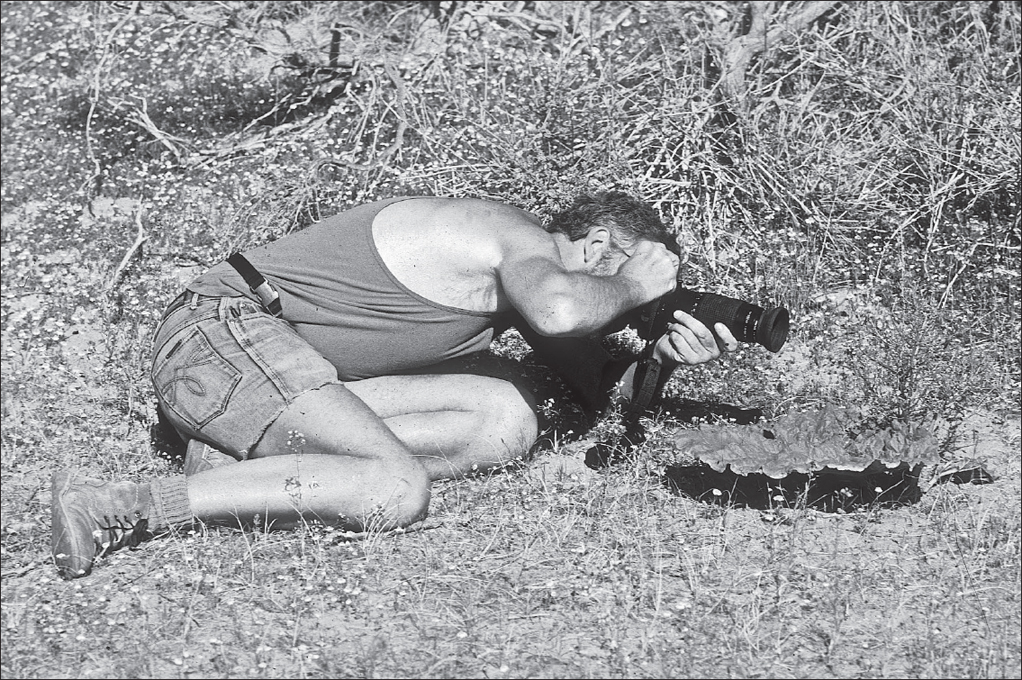
Published by
Oxbow Books, Oxford, UK
Oxbow Books and the individual authors, 2009
A CIP record of this book is available from the British Library
ISBN 978-1-84217-354-1
EPUB ISBN: 978-1-78297-331-7
PRC ISBN: 978-1-78297-332-4
This book is available direct from:
Oxbow Books, Oxford, UK
(Phone: 01865-241249; Fax: 01865-794449)
and
The David Brown Book Company
PO Box 511, Oakville, CT 06779, USA
(Phone: 860-945-9329; Fax: 860-945-9468)
or from our website
www.oxbowbooks.com
Cover images of traditional agriculture in central and northern Turkey, 1985.1995
Front (upper): Common millet (Panicum miliaceum);
(main image): threshing wheat with oxen-drawn sledge; (lower): boiling wheat grains for bulgur.
Back (upper left): steppe landscape; (upper right): otation machine at Hallan emi excavations;
(lower left): our mill; (lower right): sickle harvesting of wheat.
Photos: Mark Nesbitt and Delwen Samuel
Printed and bound in Great Britain by
The Short Run Press
Exeter
Contents
David R. Harris
Andrew M. T. Moore
George Willcox
Mark A. Blumler and J. Giles Waines
Joy McCorriston
Dorian Q Fuller and Chris J. Stevens
Martin Jones
Fsun Ertu
Sarah Mason and Mark Nesbitt
Ksenija Borojevi
Ann Butler
Leonor Pea-Chocarro, Lydia Zapata Pea, Jess Emilio Gonzlez Urquijo and Juan Jos Ibez Estvez
Amr Al Azm
Dominique de Moulins and Carl Phillips
Michle Wollstonecroft
Michael A. Monk and Ellen Kelleher
Ehud Weiss
Danile Martinoli
Ursula Thanheiser
Marie Scott Standifer, Jenna Tedrick Kuttruff, and Shirley Cotter Tucker
Jean Kennedy
Elena A. Sergusheva and Yury E. Vostretsov
Anaya Sarpaki
M. E. Kislev
Naomi F. Miller and Alhena Gadotti
A. J. Clapham and P. A. Rowley-Conwy
Mary Anne Murray
Marijke van der Veen, Jacob Morales and Alison Cox
Introduction:
In honour of Professor Gordon C. Hillman
Andrew S. Fairbairn and Ehud Weiss
It is with great pleasure that we present 28 academic papers honouring the career of archaeobotanist Professor Gordon C. Hillman. We offer the papers in celebration of Gordons significant and lasting contribution to our understanding of ancient plant use. For many contributing authors and both editors, this work is also about saying thank you to a mentor and tutor, regarded with great affection as both a colleague and friend. Two stimuli led to the publication, the first being Gordons early retirement in 1997 and the second being the award in 2004 of the Distinguished Economic Botanist award by the Society for Economic Botany. That award recognized Gordons considerable contribution to our understanding of plant use, especially the key subject of agricultural origins, one that Gordon has done much to illuminate through experimental, ethnobotanical and archaeological research. The award was accompanied by a session of 14 oral papers presented as a tribute to Gordons achievements, which form the core of this volume. Following the 2004 meeting, additional papers were contributed by a number of Gordons colleagues wishing to honour Gordons influence. The final volume contains papers covering a wide range of themes, periods and geographical regions, providing an accurate reflection of just how broad Gordons influence on archaeobotany has been. Many of his favourite research topics are represented through the work of close colleagues and a large number of the students Gordon formally and informally mentored.
We have divided the papers in this volume into four sections, though note that some papers could have sat in more that one. provide personal reflections on Gordons career from three of his longest and most valued professional colleagues Andrew Moore, David Harris and George Willcox. They contain some deeply felt and incisive comments on Gordons contributions to the study of the origins of agriculture, near eastern archaeobotany and archaeobotany as a whole, and are accompanied by photographs showing some familiar Gordon field poses, including the plate used for the frontispiece by David Harris of Gordon stalking the wild rhubarb of Turkmenistan. Gordons long and fruitful partnership with David Harris also led to a key publication in global archaeobotany, namely the 1989 Foraging and Farming volume, which showcased studies of past plant use from all parts of the world for the wider archaeological community and is of course echoed in the title of this festschrift.
A second section includes papers that explore some aspects of archaeobotanical theory and method, areas to which Gordon has made significant and lasting contributions. The paper by Mark Blumler and Giles Waines, and that by Martin Jones discuss issues surrounding the seasonality of crop production, including respectively a discussion of the problems and potential for spring sowing in the ancient Near East and the use of seed dormancy as a source of information about ancient plant husbandry. Both are topics close to Gordons heart, explored through some of his pioneering ethnoarchaeological work in Turkey and Syria. Joy McCorristons at times humorous, challenging and incisive paper provides both a review of archaeobotanys theoretical history and a timely call for a reconsideration of the subjects future research goals and theoretical orientation, exploring territory beyond the confines of materialist discourse. Dorian Fuller and Chris Stevens paper provides an equally challenging essay providing an agenda for archaeobotanical research in contributing more fully to understanding social organization in complex societies, illustrated through examples spanning the globe.
Gordon Hillman pioneered the systematic use of ethnobotany to provide models of plant management, use, and discard applicable to the archaeological record, based on the Turkish fieldwork undertaken while a fellow at the British Institute of Archaeology in Ankara. As well as providing testable archaeological models, that research also functioned to record rapidly disappearing plant-use practices for posterity. Gordon recognized that fact and inspired in many students the urge to research and record plant use in their home countries and other regions where globalization threatens traditional practice. Several of those students are represented in the third section of the book, here providing valuable ethnoarchaeological AND cultural studies of a relevance extending way beyond the confines of archaeology. Pleasingly, they include two studies located in Turkey, the paper by Fsun Ert dispelling the myth that wild plants only provide famine foods in agricultural societies and that by Sarah Mason and Mark Nesbitt providing evidence for widespread and recent use of acorns as a staple food in Anatolia. Both papers challenge established assumptions about the role of plants routinely applied to past societies. The other papers in this section draw on ethnographic field studies across the Old World, and include detailed descriptions of crop processing activities in Morocco and Syria (Pena-Chocarro et al.), the use of water-chestnut (Borojevic) and doum palm (De Moulins and Phillips), with Ann Butlers paper discussing selection in cultivated legumes. All of these papers provide new and detailed accounts of plant use, in several cases providing direct links to the archaeological record. Experimental archaeology, another form of enquiry Gordon encouraged in his students, is also represented here, including a study of tuber harvesting in Gordons native Sussex (Wollstonecroft) and experimental reconstructions of corn-drying kilns in Ireland (Monk and Kelleher).
Next page
